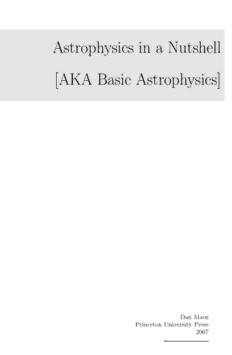Table Of ContentAstrophysics in a Nutshell
[AKA Basic Astrophysics]
Dan Maoz
Princeton University Press
2007
basicastro4 October26,2006
Basic Astrophysics
basicastro4 October26,2006
basicastro4 October26,2006
Basic Astrophysics
Dan Maoz
PRINCETON UNIVERSITY PRESS
PRINCETON AND OXFORD
basicastro4 October26,2006
ToOrit,Lia,andYonatan–thethreebrightstarsinmysky;and
tomyparents.
basicastro4 October26,2006
Contents
Preface vii
AppendixConstantsandUnits xi
Chapter1. Introduction 1
1.1 ObservationalTechniques 1
Problems 8
Chapter2. Stars: BasicObservations 11
2.1 ReviewofBlackbodyRadiation 11
2.2 MeasurementofStellarParameters 15
2.3 TheHertzsprung-RussellDiagram 28
Problems 30
Chapter3. StellarPhysics 33
3.1 HydrostaticEquilibriumandtheVirialTheorem 34
3.2 MassContinuity 37
3.3 RadiativeEnergyTransport 38
3.4 EnergyConservation 42
3.5 TheEquationsofStellarStructure 43
3.6 TheEquationofState 44
3.7 Opacity 46
3.8 ScalingRelationsontheMainSequence 47
3.9 NuclearEnergyProduction 49
3.10 NuclearReactionRates 53
3.11 SolutionoftheEquationsofStellarStructure 59
3.12 Convection 59
Problems 61
Chapter4. StellarEvolutionandStellarRemnants 65
4.1 StellarEvolution 65
4.2 WhiteDwarfs 69
4.3 SupernovaeandNeutronStars 81
4.4 PulsarsandSupernovaRemnants 88
4.5 BlackHoles 94
4.6 InteractingBinaries 98
Problems 107
basicastro4 October26,2006
vi CONTENTS
Chapter5. StarFormation,HIIRegions,andISM 113
5.1 CloudCollapseandStarFormation 113
5.2 HIIRegions 120
5.3 ComponentsoftheInterstellarMedium 132
5.4 DynamicsofStar-FormingRegions 135
Problems 136
Chapter6. TheMilkyWayandOtherGalaxies 139
6.1 StructureoftheMilkyWay 139
6.2 GalaxyDemographics 162
6.3 ActiveGalacticNucleiandQuasars 165
6.4 GroupsandClustersofGalaxies 171
Problems 176
Chapter7. Cosmology–BasicObservations 179
7.1 TheOlbersParadox 179
7.2 ExtragalacticDistances 180
7.3 Hubble’sLaw 186
7.4 AgeoftheUniversefromCosmicClocks 188
7.5 IsotropyoftheUniverse 189
Problems 189
Chapter8. Big-BangCosmology 191
8.1 TheFriedmann-Robertson-WalkerMetric 191
8.2 TheFriedmannEquations 194
8.3 HistoryandFutureoftheUniverse 196
8.4 FriedmannEquations:NewtonianDerivation 203
8.5 DarkEnergyandtheAcceleratingUniverse 204
Problems 207
Chapter9. TestsandProbesofBigBangCosmology 209
9.1 CosmologicalRedshiftandHubble’sLaw 209
9.2 TheCosmicMicrowaveBackground 213
9.3 AnisotropyoftheMicrowaveBackground 217
9.4 NucleosynthesisoftheLightElements 224
9.5 QuasarsandOtherDistantSourcesasCosmologicalProbes 228
Problems 231
AppendixRecommendedReadingandWebsites 237
Index 241
basicastro4 October26,2006
Preface
Thistextbookisbasedontheone-semestercourse“IntroductiontoAstrophysics”,
takenbythird-yearPhysicsstudentsatTel-AvivUniversity,whichItaughtseveral
times in the years 2000-2005. My objective in writing this book is to provide an
introductoryastronomytextthatissuitedforuniversitystudentsmajoringinphysi-
calsciencefields(physics,astronomy,chemistry,engineering,etc.),ratherthanfor
awideraudience,forwhichmanyastronomytextbooksalreadyexist. Ihavetried
tocoveralargeandrepresentativefractionofthemainelementsofmodernastro-
physics, including some topics at the forefront of current research. At the same
time,Ihavemadeanefforttokeepthisbookconcise.
I covered this material in approximately 40 lectures of 45 min each. The text
assumes a level of math and physics expected from intermediate-to-advanced un-
dergraduatesciencemajors,namely,familiaritywithcalculusanddifferentialequa-
tions, classical and quantum mechanics, special relativity, waves, statistical me-
chanics,andthermodynamics. However,Ihavemadeanefforttoavoidlongmath-
ematicalderivations,orphysicalarguments,thatmightmasksimplerealities.Thus,
throughoutthetext,Iusedevicessuchasscalingargumentsandorder-of-magnitude
estimatestoarriveattheimportantbasicresults.Whererelevant,Ithenstatethere-
sultsofmorethoroughcalculationsthatinvolve,e.g.,takingintoaccountsecondary
processeswhichIhaveignored,orfullsolutionsofintegrals,orofdifferentialequa-
tions.
Undergraduatesareoftentakenabackbytheirfirstencounterwiththisorder-of-
magnitudeapproach. Ofcourse,fullandaccuratecalculationsareasindispensable
inastrophysicsasinanyotherbranchofphysics(e.g.,anomittedfactorofπ may
not be important for understanding the underlying physics of some phenomenon,
butitcanbeveryimportantforcomparingatheoreticalcalculationtotheresultsof
anexperiment).However,mostphysicists(regardlessofsubdiscipline),whenfaced
withanewproblem, willfirstcarryoutarough, “back-of-the-envelope”analysis,
thatcanleadtosomebasicintuitionabouttheprocessesandthenumbersinvolved.
Thus, theapproach wewill followhere isactually valuableand widelyused, and
thestudentiswell-advisedtoattempttobecomeproficientatit. Withthisobjective
inmind,somederivationsandsometopicsareleftasproblemsattheendofeach
chapter (usually including a generous amount of guidance), and solving most or
all of the problems is highly recommended in order to get the most out of this
book. I have not provided full solutions to the problems, in order to counter the
temptation to peek. Instead, at the end of some problems I have provided short
answersthatpermittocheckthecorrectnessofthesolution,althoughnotincases
wheretheanswerwouldgiveawaythesolutiontooeasily(physicalsciencestudents
basicastro4 October26,2006
viii PREFACE
are notoriously competent at “reverse engineering” a solution – not necessarily
correct–toananswer!).
Thereismuchthatdoesnotappearinthisbook. Ihaveexcludedalmostallde-
scriptionsofthehistoricaldevelopmentsofthevarioustopics,andhave,ingeneral,
presented them directly as they are understood today. There is almost no attri-
bution of results to the many scientists whose often-heroic work has led to this
understanding,achoicethatcertainlydoesinjusticetomanyindividuals,pastand
living. Furthermore,notalltopicsinastrophysicsareequallyamenabletothetype
ofexpositionthisbookfollows,andInaturallyhavemypersonalbiasesaboutwhat
ismostinterestingandimportant. Asaresult,thecoverageofthedifferentsubjects
isintentionallyuneven: someareexploredtoconsiderabledepth,whileothersare
presentedonlydescriptively,givenbriefmention,orcompletelyomitted.Similarly,
in some cases I develop from “first principles” the physics required to describe a
problem,butinothercasesIbeginbysimplystatingthephysicalresult,eitherbe-
causeIexpectthereaderisalreadyfamiliarenoughwithit,orbecausedeveloping
itwouldtaketoolong. Ibelievethatallthesechoicesareessentialinordertokeep
the book concise, focused, and within the scope of a one-term course. No doubt,
many people will disagree with the particular choices I have made, but hopefully
willagreethatallthathasbeenomittedherecanbecoveredlaterbymoreadvanced
courses(andthereadershouldbeawarethatproperattributionofresultsisthestrict
ruleintheresearchliterature).
Astronomers use some strange units, in some cases for no reason other than
tradition. Iwillgenerallyusecgsunits,butalsomakefrequentuseofsomeother
units that are common in astronomy, e.g., A˚ngstroms, kilometers, parsecs, light-
years, years, Solar masses, and Solar luminosities. However, I have completely
avoidedusingormentioning“magnitudes”,thepeculiarlogarithmicunitsusedby
astronomers to quantify flux. Although magnitudes are widely used in the field,
theyarenotrequiredforexplaininganythinginthisbook,andmightonlycloudthe
realissues. Again, studentscontinuingtomoreadvancedcoursesandtoresearch
caneasilydealwithmagnitudesatthatstage.
Anoteonequalitysymbolsandtheirrelatives. Iusean“=”sign,inadditionto
casesofstrictmathematicalequality,fornumericalresultsthatareaccuratetobetter
thantenpercent. Indeed, throughoutthetextIuseconstantsandunittransforma-
tionswithonlytwosignificantdigits(theyarealsolistedinthisformin“Constants
and Units”, in the hope that the student will memorize the most commonly used
amongthemafterawhile),exceptinafewplaceswheremoredigitsareessential.
An “≈” sign in a mathematical relation (i.e., when mathematical symbols, rather
than numbers, appear on both sides) means some approximation has been made,
andinanumericalrelationitmeansanaccuracysomewhatworsethantenpercent.
A “∝” sign means strict proportionality between the two sides. A “∼” is used in
twosenses. Inamathematicalrelationitmeansanapproximatefunctionaldepen-
dence. For example, if y = ax2.2, I may write y ∼ x2. In numerical relations, I
use“∼”toindicateorder-of-magnitudeaccuracy.
This book has benefitted immeasurably from the input of the following col-
leagues, to whom I am grateful for providing content, comments, insights, ideas,
andmanycorrections:T.Alexander,R.Barkana,M.Bartelmann,J.-P.Beaulieu,D.
basicastro4 October26,2006
PREFACE ix
Bennett,D.Bram,D.Champion,M.Dominik,H.Falcke,A.Gal-Yam,A.Ghez,O.
Gnat,A.Gould,B.Griswold,Y.Hoffman,M.Kamionkowski,S.Kaspi,V.Kaspi,
A. Laor, A. Levinson, J. R. Lu, J. Maos, T. Mazeh, J. Peacock, D. Poznanski, P.
Saha, D. Spergel, A. Sternberg, R. Webbink, L. R. Williams, and S. Zucker. The
remainingerrorsare,ofcourse,allmyown.OritBergmanpatientlyproducedmost
ofthefigures–onemoreofthemanythingsshehasgrantedme, andforwhichI
amforeverthankful.
D.M.
Tel-Aviv,2006

